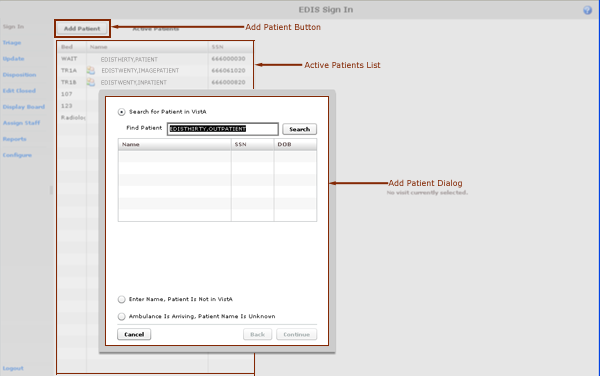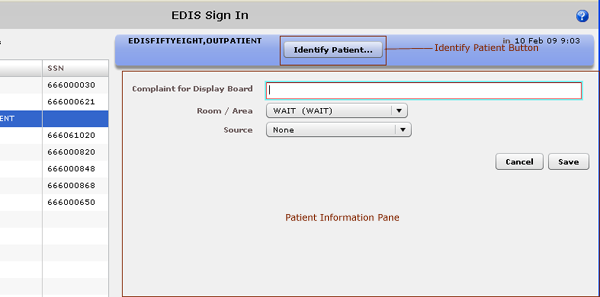Sign In View
EDIS automatically adds patients when you use VistA’s Scheduling (Appointment Management) package to create an emergency department appointment for patients.
The EDPF LOCATION parameter, which holds your site’s emergency department location or locations, controls this functionality. Parameter settings ensure that only emergency-department check ins and appointments add patients to EDIS.
You can also add patients to the application from its Sign In and Triage views.
The Sign In view encompasses four areas:

The Add Patient dialog box.
Click Add Patient in the upper right-hand corner of the Active Patients list. Keyboard users: use the TAB key to locate the Add Patient button and then press the SPACEBAR key to select it. The application displays the Add Patient dialog box, which offers the following three selections:
The Identify Patient button allows you to associate the emergency-department tracking records of patients who were added using the Enter Name, Patient Is Not in VistA or Ambulance Is Arriving, Patient Name Is Unknown selections with their electronic records in VistA. This button is located on the Patient Information bar.
| Note: | EDIS does not activate the Add Patient button when you are already in the process of signing in a patient or updating a patient’s sign-in information. To activate the Add Patient button in either of these cases, you must click Save to complete the sign-in process or Cancel to cancel the process and discard the information you’ve entered. Keyboard users: press the TAB key to locate the Cancel or Save button. Press the SPACEBAR key to select the button of your choice. |
Search for Patient in VistA
- If necessary, select Search for Patient in VistA. (Search for Patient in VistA is the application’s default selection; in most cases, you won’t need to manually select this button.) Keyboard: if the Search for Patient in VistA button isn’t already selected, use the TAB key to locate the button that is selected (Enter Name, Patient Is Not in VistA or Ambulance Is Arriving, Patient Name Is Unknown). Use the UP ARROW key to locate the Search for Patient in VistA button and use the SPACEBAR key to select it.
- Type all or part of the patient’s name in the Find Patient box using this format: Surname,Firstname. For example, you can search using the patient’s surname only, or the patient’s surname and the first initial of his or her first name. You can also search using the initial letter of the patient’s surname concatenated with the last four digits of his or her Social Security number (X9999 format), the patient’s entire Social Security number (SSN), or the last four digits of his or her SSN.
- Click Search or press the ENTER key.
- The Add Patient dialog box lists possible matches. Select the correct patient and press the ENTER key or click Continue. Keyboard: use the DOWN ARROW and UP ARROW keys to locate the correct patient, and then press the ENTER key to select the patient. You can also use the TAB key to locate the Continue button and then press the SPACEBAR key to select the button. The application displays the Patient Information pane.
Enter Name, Patient Is Not in VistA
If the Find Patient search list does not contain a match, add the patient using the Enter Name, Patient Is Not in VistA selection.
- Select Enter Name, Patient Is Not in VistA. Keyboard: use the TAB key to locate the currently selected button and then use the DOWN ARROW or UP ARROW key to locate the Enter Name, Patient Is Not in VistA button. Press the SPACEBAR key to select this button.
- EDIS automatically populates the Patient Name box with the name you typed to initiate a VistA search. If this name is incorrect or incomplete, type the patient’s full name in the Patient Name box using this format: Lastname,Firstname. Keyboard: use the TAB key to locate the Patient Name box.
- Press the ENTER key or click Continue. The application displays the Patient Information pane.
Adding Unidentified Patients
When you must add unresponsive patients whose identities you do not know, use the Enter Name, Patient Is Not in VistA selection and follow the naming protocol defined in section 12 of VHA Directive 2006-036: Data Quality Requirements for Identity Management and Master Patient Index Functions. (Use the name UU-UNRESPONSIVE,PATIENT for the first such patient, UU-UNRESPONSIVE,PATIENT A for the second, UU-UNRESPONSIVE,PATIENT B for the third, and so forth.) You can find the full text of this directive at http://www1.va.gov/vhapublications/ViewPublication.asp?pub_ID=1434.
Ambulance Is Arriving, Patient Name Is Unknown
The application enables you to add unknown patients who are arriving by ambulance or other types of emergency transportation, thereby allowing you to make room, provider, and nurse assignments before these patients arrive.
- Select Ambulance Is Arriving, Patient Name Is Unknown. Keyboard: use the TAB key to locate the currently selected button, and use the DOWN ARROW key to locate the Ambulance Is Arriving, Patient Name Is Unknown button. Press the SPACEBAR key to select this button.
- Click Continue. Keyboard: use the TAB key to locate the Continue button and use the SPACEBAR key to select it. The application displays the Patient Information pane.

The Patient Information pane.
The EDIS TWG has provided the following definitions for nationally released source selections:
Non-VA Clinic/Office—a non-VA clinic, primary care, or other type of provider sent the patient.
VA Clinic, Off-Site—an offsite VA clinic—a community-based outpatient clinic (CBOC), for example—sent the patient.
On-Site Clinic—an onsite physician, nurse practitioner, physician assistant, nurse, or other care provider sent the patient for evaluation.
Non-VA Nursing Home—a non-VA community living center (CLC) sent the patient.
VA Nursing Home, Off-Site—an off-campus VA CLC transferred the patient.
On-Site Nursing Home—an on-campus VA CLC transferred the patient.
Self-Referred—the patient presents from outside the community without a referral—regardless of his or her mode of transportation.
Transfer, Other—other facilities transferred the patient (VA ED-to-ED transfers for subspecialty care would fall into this category).